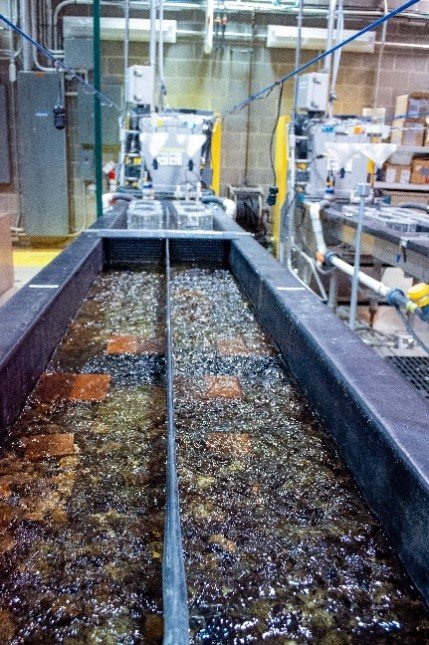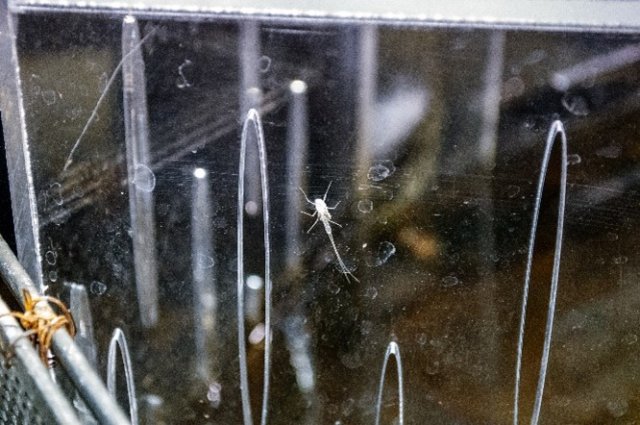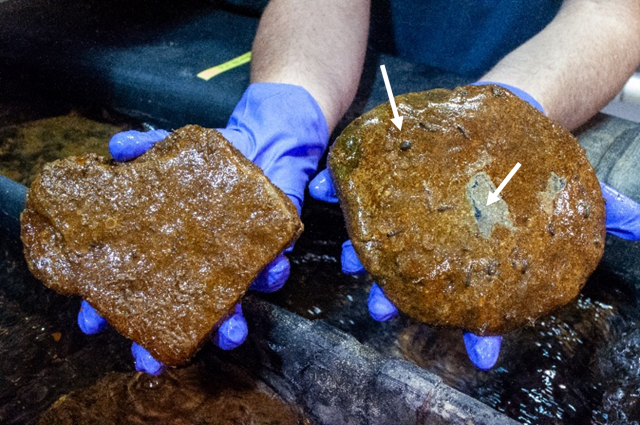Current Affairs: Studying Oil Spills in Freshwater Streams
Published October 15, 2024

The rushing sounds of bubbling, flowing water fill the air. Bright light floods down and sparkles on the rippling surface of the streams. Mayflies hover nearby and little minnows dart through the shallow waters, taking cover under rocks. But this isn’t the great outdoors – it’s EPA’s unique, world-class Experimental Stream Facility (ESF) just east of Cincinnati, Ohio. The facility houses a large high-bay laboratory space filled with 16 stream channels, each nearly 30 feet long and equipped with a variety of monitoring instruments. The channels are designed to mimic a natural stream ecosystem, complete with actual river rocks, organisms, and water from the nearby East Fork of the Little Miami River flowing through them. Researchers can use this system of engineered streams – or mesocosms – to study the effects of emerging contaminants, nutrients, and other pollutants on an entire stream ecosystem.
“Over the 18 years of operating the ESF, we have developed mesocosm set-up, colonization, and sampling procedures to increase the ecological realism of experiments and optimize results for assessing impacts on whole biological communities”, said Dr. Chris Nietch, a senior ecologist directing research at the facility since 2006.

This summer, researchers conducted a first of its kind study at ESF to understand the ecological impacts of oil spills in freshwater ecosystems. Thousands of inland oil spills occur annually. While the amount of oil is generally smaller than marine spills, freshwater spills can have serious risks due to the greater likelihood of the spill occurring within waterbodies close to populated areas or drinking water inlets. Much of oil toxicity research has focused on saltwater species, in part due to large scale assessments after the Deepwater Horizon spill. Investigating oil toxicity to freshwater species is critical as these systems are ecologically important and interconnected to drinking water health and natural resources. This is valuable information for the spill response community, particularly for the EPA when making evidence-based decisions during a freshwater oil spill.
“Most oil exposure studies are done at the bench scale, in laboratory flasks with a single species, and not in natural river waters,” said Dr. Robyn Conmy, a chemical oceanographer who leads EPA’s oil spill response support research. The flask-based approach provides a narrow view of the ecological effects of an oil spill. At ESF, the mesocosms and the life within them – including insects, fish, mussels, diatoms, and other microbes – allow researchers to study the effects of an oil spill on the entire ecosystem.

“ESF provides a very unique opportunity for us to scale up and look at oil exposure at the community level all the way down to the population and individual scales,” Conmy explained. The design of the mesocosms provide a realistic simulation of the natural stream environment but allows for tightly controlled conditions and monitoring. “You’re getting a holistic view of the impacts of oil dissolved in water to these organisms and this system,” Conmy said.
To conduct their novel study, EPA researchers designed and engineered an innovative mixing process to extract the portion of oil that typically dissolves in water – also the most toxic portion – and pumped the mixture into the streams at two different concentrations and two different durations. After the streams were dosed with the oil mixture, researchers collected a variety of samples to analyze the oil compounds in the water, examine water quality, and characterize algal populations and changes in the microbial community. The team also used a unique emergence protocol, developed by researchers at ESF, to capture aquatic insects as they exited the larval stage. Larval mayflies and other aquatic insects can be used to monitor stream health; quantifying if larval mayflies make it to the adult stage is one way to determine if there was an impact from the oil exposure. All this data helps researchers understand how different amounts of oil in a spill affect the ecological health of a stream, and whether (and when) the organisms can recover.

Preliminary results showed insect emergence substantially declined in the stream mesocosms contaminated with oil. Researchers also observed changes in the stream periphyton community (e.g., diatoms and other algae, important food sources for organisms in streams) in the oiled streams compared to the control (unoiled) streams.
“The goal of this work was to build a bridge between bench-top biological experiments and information collected in the field during an actual oil spill event,” said Dr. Kiara Lech, a research biologist working on the project. “Our hope is that by conducting these controlled, yet environmentally relevant mesoscale oil exposure studies, we not only will have a better understanding of the effects of oil spills at the ecosystem level, but also provide data that will lead to improved laboratory test methods.”
This innovative project with its pioneering approaches is expected to improve the oil spill response community’s understanding of the risks of spilled oil in freshwater ecosystems. Potential follow-up studies at the ESF include investigating the ecological impacts of sunken oil (such as oiled rocks or other substrate) and introducing oil spill treating agents into the stream mesocosms. Ultimately, this research will allow responders to make evidence-based decisions regarding response options and enable the protection of their communities in the event of an inland, freshwater oil spill.
